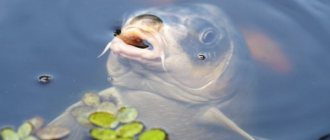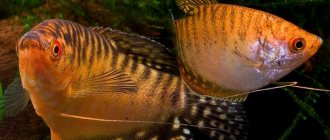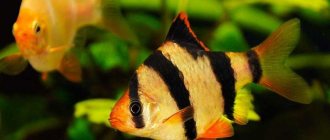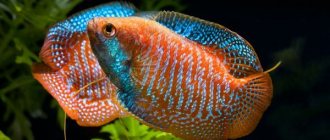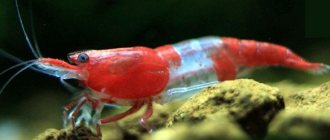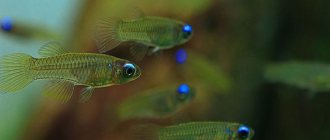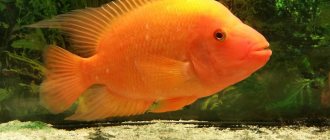Cichlazoma Meeka is one of the most popular species of cichlids. It is distinguished by its bright colors, peaceful disposition and low demands, thanks to which even a novice aquarist can easily get one. The calm nature allows the fish to get along with different types of fish, but it is advisable to keep it with larger inhabitants of aquariums.
Cichlazoma meeka is a popular type of aquarium fish with a peaceful disposition.
Living in the wild
Meek's cichlid was first described in 1918 by the scientist Brind . Its main distribution area is Central America, namely:
- Mexico;
- Honduras;
- Guatemala;
- Salvador;
- Panama;
- Costa Rica.
In addition, cichlizoma has adapted well to the reservoirs of Singapore and Colombia. Some individuals still prefer to live in their natural environment, but the majority of these fish are bred in aquariums.
Cichlazomas usually inhabit the lower and middle layers of the water column in rivers, ponds and canals where there is a sandy or silty bottom type. Basically, they stay close to those areas that are well overgrown. They can eat both plant foods and foods of animal origin.
Introduction
Many lovers of American cichlids consider Meek's cichlid one of the most beautiful aquarium fish. The first mention of this fish is found in the literature of the early 20th century - then this cichlid was described by the American scientist Walter Brind. Cichlazoma was named after the American ichthyologist Evgeniy Meek.
— Advertising —
At first, fish of this variety were classified as belonging to the genus Cichlasoma; later they were assigned to the genus Thorichthys. But the old name stuck so well that even now this cichlid is called Meek’s cichlid. In Latin the name of the fish is Thorichthys meeki, in Russian it is also called masked cichlosoma or redneck.
Under natural conditions, the fish is found in the waters of the Yucatan Peninsula, Mexico, and Guatemala.
In home aquariums, Cichlazoma Meeka can grow up to 12 cm. The body of the fish is tall, elongated in length and strongly curved from the back. The head of the fish is somewhat elongated with a very small mouth opening. The dorsal fin, like the anal fin, starts from the middle part of the body and ends at the very beginning of the tail fin, which in outline resembles a lyre. The paired fins are transparent with small turquoise spots. The unpaired fins have a red border. The iris of the eye is a brilliant turquoise hue. The body from the abdomen and the lower part of the gill covers are colored in various varieties of red, which is why the fish is called redneck. The gill covers have dark markings that resemble the pupils of eyes. In case of danger from the cichlid, Meeka spreads her gills to frighten the enemy. In a calm state, the gills acquire normal sizes. Because of this ability to dramatically change its appearance, the fish began to be called “mask fish”.
Male cichlazoma Meeka have a pronounced territorial character: they occupy an area at the bottom of the aquarium and protect it from uninvited guests. Females and fry lead a gregarious lifestyle.
— Advertising —
In aquarium conditions, Cichlazoma Meeka lives from 5 to 10 years.
Main characteristics
The fish has a slender body, which is slightly compressed on the sides. She has a sloping forehead and a pointed muzzle. In nature, cichlazoma can grow up to seventeen centimeters. For cichlids this size is modest , but in aquariums they are usually even smaller - only 10-12 cm. Males are slightly larger than females.
Cichlazomas live for about 10-12 years. Their coloring is bright and very interesting. The brightest shade - red - is present on the gills and throat. The same color goes a little onto the tummy. The main body color of the fish is silver-gray with a purple tint and dark vertical spots. Depending on the habitat, the color may vary slightly.
Particularly original specimens
Auratus Cichlids
The species Auratus should be mentioned in this section. These fish have a second extravagant name: golden parrot. Females and males of Auratus differ significantly in color, which makes the choice easier at the time of pair formation, since the female of Auratus is even more pugnacious than the male. It is interesting that if there is no male in the house (aquarium), the most active and respected female can change her color and become like a male auratus. Auratus does not have the opposite effect.
The southern Malawian reservoir is the place where the blue dolphin originated - a striking representative of the cichlid, strongly reminiscent of the mammal of the same name. The pad on the male's forehead grows year by year, making the fish more and more like him. The success of their home breeding depends entirely on the health of the parents, which requires:
- bright lighting;
- filtering or changing a third of the water weekly;
- maintaining an alkaline pH.
Pseudotropheus Lombardo
A few words about the uniqueness of the cichlid pseudotropheus (Lombardo)
It is important that only experienced aquarists can properly maintain a pawnshop. These are beautiful, aggressive, extremely sensitive to changes in water.
Female and male Lombardos are so differently colored that they are sometimes mistaken for different species. Lombardos do not get along even with peaceful cichlids.
Three-hybrid parrot - Cichlasoma flowerhorn
Three-hybrid parrot - Cichlasoma flowerhorn. This is the result of the selection work of ichthyologists. In addition to a highly developed bump on the forehead, it is characterized by:
- frequent radical changes in color;
- tendency to loneliness;
- the presence on the scales of a pattern similar to a heart.
Fish care rules
Cichlazoma Meeka is a fairly simple fish to keep; even a novice aquarist can handle it without any problems. Representatives of this species adapt well to new conditions and are considered unpretentious fish. In their natural environment, they live in water of different composition and temperature, so they have learned to adapt well. But this does not mean that you don’t need to take care of them.
As for food, such pets are picky and omnivorous. They can eat any food:
- alive;
- artificial;
- frozen.
But in order for the fish to be healthy, it should be provided with a varied diet. The main food can be special food for cichlids, which contains everything you need. In addition, cichlid needs to be fed with frozen food . Bloodworms should be given to her in moderation, otherwise she may have problems with the gastrointestinal tract.
Feeding
Omnivores, eat all types of food well - live, frozen, artificial. Varied feeding is the basis for fish health, so it is advisable to add all of the above types of food to the diet.
For example, the basis can be high-quality food for cichlids, they have everything you need. Additionally, you need to give live or frozen food, just don’t get carried away with bloodworms, as it can cause inflammation of the gastrointestinal tract in fish.
Keeping in an aquarium
For two cichlids, an aquarium should be selected with a volume of at least 150 liters. If there are more fish, then an aquarium will need a capacity of at least 200 liters. Water for fish should be clean and have a moderate current. An external filter is well suited for these purposes.
In addition, in an artificial reservoir it is necessary to replace the water by 20% once a week. Meeka fish likes to dig into the ground, so it is better to put sand on the bottom. Pets will also build nests in it if they reproduce. There should also be shelters in the aquarium, which can be built from driftwood, stones, pots and other materials. Meeka cichlids love to stay in shelters and protect their territory.
Meeka likes to dig in the ground, so you need to pour sand on the bottom of the aquarium
It is preferable to plant aquarium vegetation in small pots, since fish can dig through and damage it. For plants, it is better to choose large and tough species, such as Echinodorus or Anubias.
Cichlids are able to adapt to any living conditions, but it is desirable that the water temperature in the tank be maintained at 24-26 °C and the pH is 6.5-8.0. If you keep fish in suitable conditions, they can live for quite a long time.
General information
Cichlazomas is the historical name of a group of fish of the Cichlid family. At one time, most representatives of Central American cichlids belonged to this genus. After repeated revisions based on new scientific data, modern taxonomists abolished this genus, and the species included in it were distributed into other systematic groups. But the name is so firmly attached to certain species of fish that even in our time they are called cichlazomas in the old fashioned way.
Distinctive features of cichlases are size, territoriality and high intelligence. Most of the species are true predators that in natural conditions feed on small fish. Many of them are characterized by caring for their offspring. And anyone who decides to encroach on the occupied territory (especially if we are talking about a nest) will be unquestioningly expelled. Keeping cichlases will require a large aquarium and the right selection of neighbors, so novice aquarists are not advised to have cichlases as their first pets.
Compatibility with other types
Since these cichlids have a calm and peaceful character, they can be kept without problems in a common aquarium with different fish. The compatibility of Meek's cichlazoma with other fish is quite good. They can become a little aggressive only during the spawning period. At this time, it is better to place them in a separate aquarium, since they can even kill fish that begin to bother them in their own territory.
Meeka gets along with other fish quite well and only shows aggression during spawning.
Meeks are well compatible with scalars or akars. But it is better not to keep them with Astronotus, since it is larger and more aggressive. You need to pay special attention to the aquarium vegetation, as fish can damage or undermine it.
These cichlids have proven to be good parents. They are monogamous and mate for a long time. It is allowed to contain more than one pair in an aquarium, but at the same time it must be quite spacious and it must be equipped with various types of shelters.
Suitable neighbors
Cichlazoma Meeka is a peace-loving fish; it shows aggressiveness only during spawning. During breeding, large individuals can chase and even kill other fish that come too close to the nest with clutches.
During spawning, keep an eye on the Meek’s behavior and, if necessary, temporarily remove their smaller neighbors from the common aquarium.
Peace-loving representatives of the aquarium world become the best neighbors for Cichlaz Meek:
angelfish
Akara
barbs
catfish
More aggressive, fighting in behavior and massive in size fish (for example, astronotus) are better not to settle with Meek. They have tense relationships with American Cichlids and Red-necked Cichlids.
They can coexist peacefully for some time, without noticing each other, but there is a high risk of large-scale fights resulting in injuries. This is especially risky in small aquariums.
Reproduction process
When Meek's cichlazoma is kept at home, successful regular reproduction is observed. One of the main conditions is to form a pair for spawning. This is done in several ways. You can immediately purchase an adult pair or buy several young fish that will mate later on their own.
During the spawning period, it is advisable to place the couple in a separate aquarium, which will contain a neutral type of water with pH = 7 and a hardness of about 10 °dGH. The water temperature can be left at 24−26 °C.
The female carefully cleans the stone, on which she subsequently lays eggs, numbering about five hundred eggs. After seven days, the fry emerge from them and begin to swim. Their parents take care of them, protecting them until they grow up. One pair is capable of spawning several times during the year.
Breeding
Cichlazomas themselves choose their other half and form a pair for life. The process itself is very easy and does not require any effort on the part of the aquarist. When puberty approaches at the age of 9–11 months, future parents independently begin to prepare for spawning.
Sex differences
Males are larger in size. In addition, their large fins have pointed tips, while those of females are rounded.
During the mating season, fish develop tubercles in the anal area. The outgrowths (ovipositors) in females have the shape of a truncated cone; in males, the cone is much smaller and has a pointed apex.
Getting offspring
The male finds a flat, wide stone and carefully cleans all the debris from it. If there are plants around, he pulls them out and throws them away. The female begins to spawn in the prepared area. On average, there can be from 150 to 300 eggs, from which fry will emerge in 4–5 days.
If cichlazomas do not try to spawn for a long time, you need to take care of the water parameters. The temperature should always be 26–28°, and the hardness should be no more than 10 total and no more than 2 carbonate. This can be achieved by boiling water for the aquarium.
Fry
Once born, the babies soon begin to swim and hide in rocks or thickets of plants. Parents do not leave them unattended and jealously guard both the eggs and the active fry. The male defends the nearby territory, and the female intensively works her fins over the clutch to enrich the water with oxygen.
If the aquarium is densely populated with other species of fish, it is better to transplant the cichlazoma fry into another container to avoid their death. You can feed your babies tubifex and brine shrimp, cut into small pieces.

